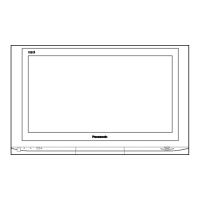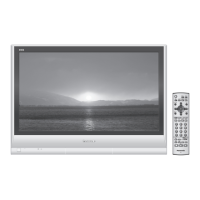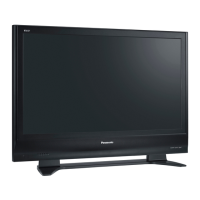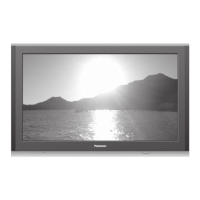
Do you have a question about the Panasonic TH-42PV500B and is the answer not in the manual?
Explains the differences between analogue and digital TV transmission methods.
Advises on avoiding permanent image retention on the plasma display.
Critical precautions for electrical safety, water exposure, and general appliance handling.
Instructions for safe use of the power plug, including fuse replacement and earthing.
Guidance on safe positioning, accessory compatibility, and ventilation.
Precautions during TV usage, including handling the power cord and avoiding foreign objects.
Steps to take for issues like smoke, abnormal odors, or foreign objects inside the TV.
Instructions for gently cleaning the display panel and the TV cabinet.
Verification of included items and guidance for installing ferrite cores and remote batteries.
Instructions for managing cables with the detachable cover and pedestal.
Procedure for opening the front panel door to access controls.
How to connect satellite receivers, VCRs, and DVD players using Scart and RF cables.
Powering on the TV and the automatic station tuning process.
Transferring programme information to VCRs or DVD recorders via Q-Link.
Setting up a PIN and personal details for owner identification and security.
Using the GUIDE button to view and select available TV channels.
Explanation of all buttons on the remote control and the TV's front panel.
Using the MENU, cursor, OK, and EXIT buttons to navigate settings and use help.
Configuring viewing modes like Dynamic, Normal, Cinema, and Auto.
Adjusting contrast, brightness, colour, sharpness, and tint for optimal picture quality.
Utilizing P-NR, MPEG NR, and 3D-COMB for noise reduction and picture improvement.
Adjusting bass, treble, and balance for desired sound output.
Configuring NICAM stereo, sound modes (Music, Speech), and ambience.
Choosing the audio input source when using an HDMI connection.
Configuring Q-Link, AV outputs, and Teletext modes (FASTEXT/List).
Managing power saving features and setting the off-timer.
Setting Owner ID, Shipping condition, and accessing Tuning Menu.
Overview of programme editing, auto setup, and manual tuning options.
Procedures for adding, deleting, and reordering programme channels.
Changing channel names and locking channels for restricted access.
Copying programme information to an external recording device.
Process for automatically scanning and storing local TV stations.
Step-by-step guides for tuning channels using the remote or front panel.
Setting up a PIN and personal details for owner identification and security.
Procedure to clear all tuning and settings, returning the TV to its original condition.
Setting up recordings and customizing favourite channel lists for DVB.
Locking DVB channels and accessing DVB tuning features.
Specialized DVB options and selecting alternative sound tracks.
How to program external devices to record DVB content.
Configuring recording date, time, and subtitle options for DVB broadcasts.
Managing timer recording status and setting daily/weekly frequencies.
Information regarding viewing and recording encrypted DVB programmes.
Adding, editing, and deleting channels from favourite profile lists.
Creating and managing a PIN for locking DVB channels.
Retuning DVB stations automatically and adding new services.
Managing service notifications and checking signal quality.
Accessing CI module functions and selecting preferred subtitle language.
Downloading new software and adjusting information banner display duration.
Instructions for inserting and removing Common Interface (CI) modules.
Navigating and operating functions provided by the CI module.
Steps for automatic and manual software updates for the TV.
Viewing information about the TV's software license agreement.
Using the GUIDE button, selecting categories, and choosing display styles.
Viewing programme details and setting up timer recordings from the EPG.
Understanding information displayed about current and next programmes.
Toggling subtitle display for DVB channels using the STTL button.
How Q-Link enables communication between the TV and VCR/DVD recorders.
Using the DIRECT TV REC button for immediate programme recording.
Details on preset download, auto power on/standby, and image view.
Description of aspect ratio options like 16:9, 14:9, Just, and 4:3.
How the TV automatically adjusts aspect ratio based on signal detection.
Explanation of Zoom1, Zoom2, and Zoom3 aspect ratio settings.
How to freeze the current image on the screen.
Setting up Picture-in-Picture, Picture-out-of-Picture, and Picture-and-Picture modes.
Adjusting picture quality settings like white balance and gamma for PC input.
Configuring sound parameters such as bass, treble, and balance for PC input.
Setting input resolution, clock, H-pos, V-pos, clock phase, and sync for PC input.
Instructions for inserting and removing SD and PC memory cards.
Safety advice during card access, handling, and potential data risks.
Understanding folder hierarchies and file naming conventions for memory cards.
Instructions and settings for recording TV and AV1 signals to an SD card.
Table showing recordable times based on card size and recording mode.
How to play back moving pictures recorded on SD cards.
Controlling playback, locking, and deleting files from memory cards.
Adjusting frame size and repeat modes for media playback.
How to view still images recorded by digital cameras from SD and PC cards.
Configuring slideshow interval, repeat modes, and card selection.
Configuring recording mode, time, and formatting the memory card.
Viewing the remaining recordable time on the memory card.
Explanations and solutions for common error messages related to memory card usage.
Using the TV remote to operate selected Panasonic VCRs and DVD equipment.
Explanation of basic playback controls like Play, Stop, Skip, and Pause.
Using teletext features, page selection, and display modes in analogue mode.
Managing teletext updates, news flashes, and navigating sub-pages.
Differences and interaction methods for DVB teletext services.
Using the TV/AV button to switch between various AV input sources.
Wiring the AV3 terminals and connecting headphones.
Connecting the TV's audio output to amplifiers or speaker systems.
Details for connecting devices via AV1, AV2, AV4 Scart terminals and Component inputs.
How to connect HDMI-compliant devices for digital audio and video.
Instructions for connecting computers and understanding PC input pinouts.
Identifying and resolving common visual and audio faults.
Addressing issues like no colour, distorted picture, or after-images.
Handling specific error indicators and understanding the sleep feature.
Diagnosing issues related to no DVB channels or poor signal quality.
Solutions for blocky interference and intermittent picture freezing.
Detailed information on Scart and S-Video terminal pin configurations.
Compatibility table for Component, HDMI, and PC input signal frequencies.
Key electrical, display panel, sound, and connection specifications.
TV dimensions, weight, and list of trademarks.
Contact details for customer care, direct sales, and product information.
Environmental information and instructions for responsible product disposal.











